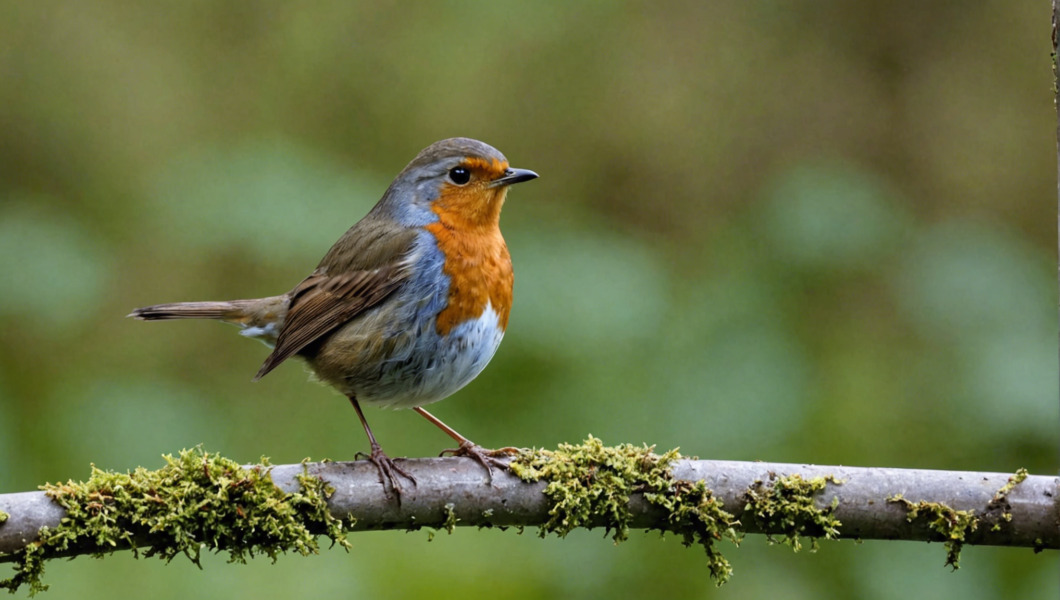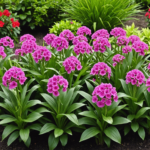The Robin: An Introduction
The charming and familiar little bird that frequents our gardens, the Robin, is a member of the Muscicapidae family. With its solitary nature and territorial behavior, the Robin has captured the hearts of gardeners and bird enthusiasts alike. Its presence brings joy as it follows us around the garden, searching for insects or enjoying the crumbs of bread we leave out for it during the winter months. The melodious songs of the Robin, filling our mornings even in urban areas, add a touch of magic to our daily lives.
About the Robin
- Order: Passeriformes
- Family: Muscicapidae
- Genus: Erithacus
- Species: rubecula
The Robin is a common bird in our gardens and belongs to the Muscicapidae family, which includes other birds such as blackbirds, nightingales, redstarts, wheatears, and thrushes, among the 331 species found in Europe and Africa. With its rounded shape, short wings, and distinct orange breast, the Robin measures around 13-14 cm in length, weighs between 15 to 22 g, and has a wingspan of 22 cm.
It is the Robin’s plumage, particularly the famous orange breast, that sets it apart from other bird species. Both males and females have the same plumage throughout the year. Their characteristic orange breast is bordered by a lighter grayish-blue band. The upper part of their body is a uniform greenish-brown color, while their tail is a warmer shade of brown and their rump a distinct grayish-brown. The rounded body of the Robin, accompanied by its small, pointed beak, and dark, expressive eyes, make it a captivating sight.
While adult Robins are easily recognizable, juveniles have a different plumage without the distinctive orange breast. Until their first partial molt, which occurs in the summer following their birth, young Robins have a speckled plumage of reddish-brown and black on the upper part of their bodies. The underside of their body has a reddish-brown dominante with brown fringes. Their beak is brown but lined with yellow at the corners. Despite their different appearance, young Robins can be mistaken for nightingales or redstarts, although they have a darker tail.
The round silhouette of the Robin is typical of the Muscicapidae family, as are its small, straight, pointed beak and its upright posture. Its dark eyes are particularly useful for finding food in dim conditions, allowing it to hop around, suddenly stop, and then resume its search for prey on its long thin legs.
A Melodious Songbird
The Robin belongs to the order Passeriformes, also known as “the order of songbirds,” which includes other birds like sparrows. The Robin lives up to its nickname, as its cheerful appearance and beautiful orange breast delight our eyes, while its typical and melodious song is a true treat for our ears. Open your ears wide, and you will hear its soft, rolling, whistling notes, accompanying our wake-ups in spring or throughout the day. When it feels anxious, the Robin emits a repeated cry of excitement, which becomes rapid if it senses danger. However, it is primarily through its melodic song that the Robin marks its territory and attracts females.
A Solitary and Territorial Bird
Although we are captivated by its charming appearance and the soothing sound of its song, the Robin is far from vulnerable and fragile. It is a solitary and highly territorial bird throughout the year, ready to fight to earn respect. Its melodious song serves primarily to warn and fend off its congeners when they approach its territory. Coupled with its red breast, the Robin ensures that its fellow birds stay at a distance.
It fiercely defends its territory, often fighting to the death if another Robin dares to step foot or feather into its territory. Determined to protect its living space and that of its offspring, the Robin does not tolerate intrusions. Whenever one of its kind enters its territory, it attacks, drawn by the famous orange color of the intruder’s breast.
Surprisingly, the Robin is not afraid of humans. It willingly settles in garages, barns, sheds, and other accessible outbuildings to nest during the winter months. It also has no qualms about perching near gardeners, taking advantage of the insects disturbed by their activities.
Geographic Distribution and Habitat
The Robin is mainly found in Europe, from the northern Baltic Sea to Gibraltar and as far east as the Ural Mountains. Some individuals can also be found in North Africa and Iran. Typically, during the winter season, the Robin originating from the northernmost regions migrates southward. In France, it is one of the most widespread species, observed all year round.
While it is primarily a forest bird, the Robin can be found in various habitats such as deciduous, coniferous, or mixed forests, as well as natural wooded areas, shrubs, parks, hedgerows, and gardens in both urban and rural areas. When selecting nesting sites, it seeks out areas with dense and low vegetation, providing shade and a cool environment. The Robin prefers bare ground or areas covered with dead leaves, as it is there that it finds its prey.
The territory of a Robin typically ranges from 1,600 to 15,000 square meters, and it defends its space ardently. From its perch, the Robin sings to warn its congeners and keep them at bay. When it detects an approaching orange breast (or even a decoy, as it may threaten its own reflection or an orange-colored fabric), it tries to intimidate the intruder, whether real or not. It raises its head, puffs out its chest, and flutters its sides. However, if the opponent persists, a fight ensues. The only exception to this fierce defense of its territory is observed during the harshest winters when some Robins nest together to keep warm and survive.
Partial Migration
Robins observed in France are predominantly sedentary individuals. However, birds living in the northernmost parts of Europe and central continents migrate either westward or southward. This migration takes place at night, with birds resting and feeding during the day.
Diet
Robins are insectivorous birds. They primarily feed on insects, spiders, larvae, woodlice, millipedes, small mollusks, and small invertebrates such as earthworms. They search for their food mostly on the ground, hopping around and only stopping to seize an insect. Occasionally, they perch on bushes and observe the ground before pouncing on their prey.
During the colder months when their primary food source becomes scarce, Robins also consume small fruits such as yew or juniper berries, blackberries, blueberries, ivy, spindle tree, elderberry, guelder rose, bird cherry, as well as dogwood. They also eat small seeds and bread crumbs if they live in urban areas. There is no need to hang fat balls for them as they cannot feed on them. It is best to scatter seeds or crumbs on the ground, ensuring that cats are kept away.
Reproduction
Robin pairs form during the winter months. However, it can be challenging for a female to court a territorial male without risking conflict. To approach without danger, the female hides her orange breast and adopts submissive postures. Nevertheless, the male Robin becomes more tolerant during this time of the year and starts singing to attract females. Mating takes place in spring, but the male does not go through an elaborate courtship ritual. Instead, he offers the female some prey to express his interest.
In April, the female Robin takes on the role of nest construction. Using twigs, grass, dry leaves, and moss, she builds her cozy nest hidden in vegetation or the cavity of an old stone wall. In some cases, a rabbit burrow, unused terracotta pot, or a mailbox can suffice as a nesting spot. She constructs a spacious nest, lining its interior with softer and more comfortable materials such as wool, feathers, small roots, or horsehair.
The female then lays 5 to 7 white eggs, speckled with reddish-brown spots, and she incubates them alone for 11 to 15 days. She rarely leaves the nest, only briefly to be fed by her partner. Once the eggs hatch, the devoted mother continues to brood over them for one to two weeks, and the male Robin directly feeds her in the nest this time. He provides both the mother and the fledglings with a protein-rich diet, mainly consisting of worms and insects.
The nestlings, weighing only 2 g at birth, reach 15 g after two weeks. At this point, they venture out of the nest to practice flying but remain close to their parents for another two to three weeks for food. As the female lays two broods each year, the male singlehandedly provides for the offspring if the second clutch starts while the first brood is still being cared for.
The Robin: Friend or Foe in the Garden?
The Robin does not cause any damage to our gardens, and we would not want to part with this little bird with its melodic song, which accompanies the arrival of the beautiful season. On the contrary, it is highly beneficial as it consumes numerous insects and invertebrates that can be detrimental to vegetable gardens and flowers. It often playfully follows gardeners around to feast on insects disturbed by their activities. Therefore, do not hesitate to welcome Robins into your property; they will be thrilled to help you eliminate unwanted pests and save you from resorting to chemical products. You can find many tips in our dedicated articles on how to attract Robins and turn them into valuable allies.
The Robin is not considered a threatened species, as it is widely spread. However, in France, it is the subject of full protection under the Ministerial Decree of October 29, 2009. It is prohibited to destroy or remove its eggs, mutilate, capture, or remove the bird, whether dead or alive, transport, sell, or purchase it. Unfortunately, poaching still occurs in some parts of the country, particularly in southern France.



